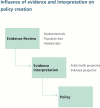Early detection of prostate cancer: AUA Guideline
- PMID: 23659877
- PMCID: PMC4020420
- DOI: 10.1016/j.juro.2013.04.119
Early detection of prostate cancer: AUA Guideline
Abstract
Purpose: The guideline purpose is to provide the urologist with a framework for the early detection of prostate cancer in asymptomatic average risk men.
Materials and methods: A systematic review was conducted and summarized evidence derived from over 300 studies that addressed the predefined outcomes of interest (prostate cancer incidence/mortality, quality of life, diagnostic accuracy and harms of testing). In addition to the quality of evidence, the panel considered values and preferences expressed in a clinical setting (patient-physician dyad) rather than having a public health perspective. Guideline statements were organized by age group in years (age <40; 40 to 54; 55 to 69; ≥ 70).
Results: Except prostate specific antigen-based prostate cancer screening, there was minimal evidence to assess the outcomes of interest for other tests. The quality of evidence for the benefits of screening was moderate, and evidence for harm was high for men age 55 to 69 years. For men outside this age range, evidence was lacking for benefit, but the harms of screening, including over diagnosis and overtreatment, remained. Modeled data suggested that a screening interval of two years or more may be preferred to reduce the harms of screening.
Conclusions: The Panel recommended shared decision-making for men age 55 to 69 years considering PSA-based screening, a target age group for whom benefits may outweigh harms. Outside this age range, PSA-based screening as a routine could not be recommended based on the available evidence.
Keywords: DRE; ERSPC; European Randomized Study of Screening for Prostate Cancer; FDA; Food and Drug Administration; PLCO; PSA; Prostate Lung, Colorectal and Ovarian; RCT; digital rectal examination; early detection of cancer; prostate specific antigen; prostate-specific antigen; prostatic neoplasms; randomized controlled trial.
Copyright © 2013 American Urological Association Education and Research, Inc. Published by Elsevier Inc. All rights reserved.
Figures
Comment in
-
Early detection of prostate cancer continues to support rational, limited screening.J Urol. 2013 Aug;190(2):427-8. doi: 10.1016/j.juro.2013.05.030. Epub 2013 May 18. J Urol. 2013. PMID: 23688640 No abstract available.
-
Re: Early detection of prostate cancer: AUA guideline: H. B. Carter, P. C. Albertsen, M. J. Barry, R. Etzioni, S. J. Freedland, K. L. Greene, L. Holmberg, P. Kantoff, B. R. Konety, M. H. Murad, D. F. Penson and A. L. Zietman J Urol 2013; 190: 419-426.J Urol. 2013 Sep;190(3):1134-7. doi: 10.1016/j.juro.2013.07.002. Epub 2013 Jul 17. J Urol. 2013. PMID: 23871525 No abstract available.
-
Words of wisdom. Re: Early detection of prostate cancer: AUA guideline.Eur Urol. 2013 Nov;64(5):857-8. doi: 10.1016/j.eururo.2013.08.041. Eur Urol. 2013. PMID: 24112614 No abstract available.
-
Reply by authors.J Urol. 2013 Sep;190(3):1137-9. J Urol. 2013. PMID: 24137618 No abstract available.
-
Words of wisdom. Re: Early detection of prostate cancer: AUA guideline.Eur Urol. 2014 Jun;65(6):1218. doi: 10.1016/j.eururo.2014.02.024. Eur Urol. 2014. PMID: 24774826 No abstract available.
References
-
- Gordis L. The Epidemiologic Approach to Evaluating Screening Programs. Epidemiology. (4th edition) 2009
-
- Faraday M, Hubbard H, Kosiak B, et al. Staying at the cutting edge: a review and analysis of evidence reporting and grading; the recommendations of the American Urological Association. BJU Int. 2009;104:294. - PubMed
-
- Schroder FH, Hugosson J, Roobol MJ, et al. Screening and prostate-cancer mortality in a randomized European study. N Engl J Med. 2009;360:1320. - PubMed
-
- Barry MJ, Edgman-Levitan S. Shared decision making--pinnacle of patient-centered care. N Engl J Med. 2012;366:780. - PubMed
Publication types
MeSH terms
Substances
Grants and funding
LinkOut - more resources
Full Text Sources
Other Literature Sources
Medical
Research Materials
Miscellaneous


